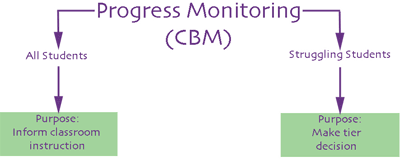How will teachers initially identify struggling readers?
Page 4: Tier 1 Components
Broadly speaking, all students receive Tier 1 services, regardless of their ability levels. As a result, many RTI practitioners consider universal screening a component of Tier 1 rather than a separate component. In this module, universal screening and Tier 1 have been treated separately simply to highlight the differences in the assessment process for these two RTI components.
During Tier 1 instruction, all students receive high-quality instruction in the general education classroom. Additionally, the students identified as struggling readers during the universal screening receive frequent monitoring of their performance.
High-Quality Instruction
 High-quality instruction is effective instruction provided to all students in the general education setting using research-validated practices. Depending on the available resources and their students’ needs, teachers may choose to provide adaptations for the identified students as part of high-quality instruction. These adaptations may include scaffolding and reteaching content.
High-quality instruction is effective instruction provided to all students in the general education setting using research-validated practices. Depending on the available resources and their students’ needs, teachers may choose to provide adaptations for the identified students as part of high-quality instruction. These adaptations may include scaffolding and reteaching content.
effective instruction
The use of research-based instruction in the classroom.
research-validated practice
A strategy or practice that has been proven to work through experimental research studies or large-scale research field studies. Referred to in a variety of ways, such as scientifically based practices and evidence-based instruction
For more information on reading instruction in the RTI approach, view the IRIS Module:
Frequent Progress Monitoring
 In conjunction with providing high-quality instruction, the teacher will need to employ frequent progress monitoring of those students identified through the universal screening as struggling. Progress monitoring is a form of assessment in which student learning is evaluated on a regular basis in order to provide useful feedback about performance to both learners and instructors.
In conjunction with providing high-quality instruction, the teacher will need to employ frequent progress monitoring of those students identified through the universal screening as struggling. Progress monitoring is a form of assessment in which student learning is evaluated on a regular basis in order to provide useful feedback about performance to both learners and instructors.
More specifically, a form of progress monitoring known as curriculum-based measurement (CBM) is used in the RTI approach. Implementing CBM allows teachers to track students’ academic progress across the school year. It is crucial to understand that Tier 1 data may be used for two distinctly different purposes:
- If the teacher chooses to collect CBM data for the entire class, the data can be used to inform classroom instruction.
- For struggling readers, the data are used to make individual RTI tier placement decisions.

CBM is useful in making tier decisions for struggling students and in informing classroom instruction for all students for the following reasons:
- Each test (probe) includes items representing the skills that students are expected to master by the end of the year.
- Probes, administration, and scoring are standardized to produce reliable and valid scores.
- Graphs of each student’s scores provide a clear visual representation of how students are progressing academically.
It is important to note that when all students are monitored, assessment results can be used not only to evaluate students’ progress but also to determine whether the class as a whole is receiving high-quality instruction.
Research Shows
- Students of teachers who use CBM achieve higher grades than students whose teachers do not use CBM.
(Fuchs, Butterworth, & Fuchs, 1989) - Students are more aware of their performance and view themselves as more responsible for their learning when they use CBM and graph their own data.
(Davis, Fuchs, Fuchs, & Whinnery, 1995)
We strongly encourage the reader to view the following IRIS Module to learn more about how to implement CBM and how to use the data to guide instruction.
Selecting a Measure
Several types of CBM measures, many of which are commercially available, can be used to track the performance of students in Tier 1. Click here to view a list of available measures.
 In all probability, the district or state—rather than individual teachers—will determine which actual measure is used. Most of these CBM reading measures require a student to identify sounds, read a list of words, or read a passage aloud for one minute. The number of correct sounds or words is recorded as the student’s score. Available CBM measures differ slightly in content, in the skills assessed, and in the benchmarks used to indicate satisfactory performance. Some sources offer non-English language versions for linguistically diverse students, and large-print versions are also available for students with visual disabilities.
In all probability, the district or state—rather than individual teachers—will determine which actual measure is used. Most of these CBM reading measures require a student to identify sounds, read a list of words, or read a passage aloud for one minute. The number of correct sounds or words is recorded as the student’s score. Available CBM measures differ slightly in content, in the skills assessed, and in the benchmarks used to indicate satisfactory performance. Some sources offer non-English language versions for linguistically diverse students, and large-print versions are also available for students with visual disabilities.
View the video below for a demonstration of how to administer a CBM probe. Pay attention to how José pronounces his words and how the teacher scores his performance. As the movie illustrates, José’s word pronunciation reflects his Mexican-American heritage (time: 2:08).
Transcript: How Will Teachers Initially Identify Struggling Readers?
Ms. Begay: Hi, José. When I say “go,” I want you to read these words as quickly and correctly as you can. Start here and go down the page. If you don’t know a word, skip it and try the next word. Keep reading until I say “stop.” Do you have any questions?
José: No.
Ms. Begay: Go.
José: Reads the word list in the movie.
Ms. Begay: Stop.
Narrator: As José reads, Ms. Begay marks a “1” for words he reads correctly and a “0” for words he reads incorrectly. When the one-minute time limit is up, Ms. Begay circles the last word read by José. To score this test, Ms. Begay counts up the number of words read correctly in one minute and writes the score at the bottom of the scoring form.
In review:
- WIF is for first-grade students or below grade-level students who are not able to read passages
- Students are presented with a list of 50 words
- Students read words for 1 minute
- Teacher marks a “1” if the response is correct and a “0” if the response is incorrect
- To determine the score, the teacher counts the number of correct responses
Listen as Leonard Baca discusses the issue of linguistic diversity in relation to administering and scoring progress monitoring probes, then listen to Alfredo Artiles discuss concerns about using Spanish translations of English language assessments.

Leonard Baca, PhD
Director, BUENO Center
for Multicultural Education
University of Colorado, Boulder
(time: 0:55)

Alfredo Artiles, PhD
Professor, College of Education,Arizona State University
Co-Principal Investigator, National Center for Culturally
Responsive Educational Systems (NCCRRESt)
(time: 1:01)
Transcript: Leonard Baca, PhD
Pronunciation is somewhat irrelevant in terms of cognitive and academic growth. There’s an acceptable American accent and pronunciation that would be nice for everyone to have, but people pronounce things differently from the Northeast, from the Southwest, etc. That is irrelevant to academic and cognitive understanding. So teachers need to be very flexible in their interpretation of pronunciation for bilingual and linguistically different kids. Allowing them to use their standard dialect and certain sounds that they might not be able to produce as some standard-English speakers might produce would count as correct, in my view, because it had nothing to do with the academic content of the material. I really think teachers need to be very open and flexible to scoring those properly because accent has nothing to do with achievement.
Transcript: Alfredo Artiles, PhD
The idea of validity is concerned with to what extent are we measuring what we are supposed to be measuring with this assessment? We assume, by translating items, that the translation is going to reflect the same constructs or notions in the second language that we were trying to get at with the English version of the test. However, when you translate items then you run into a number of problems. One, the level of difficulty of certain items, for example, in the translated version might change. Items that were perceivably easier in English, when they are translated into Spanish, they have a higher level of difficulty because of the nuances and the meanings are altered in the translation process, and vice-versa. Then you run into the issue of dialectical variations in a language. So you have subtle differences in the way the language is used and whether they might mean very different things.
The primary purpose of progress monitoring in Tier 1 is to determine which students are making adequate instructional progress and which are not. Following the universal screening, the progress of the students identified as struggling should be monitored at least once each week for a period of 6–10 weeks. After each probe is administered, the teacher or student plots the score on an individual CBM graph. Click to see a sample CBM graph. An examination of the data plotted on the CBM graph will allow the teacher to determine whether a student is making adequate progress. Assuming that students are receiving high-quality instruction in Tier 1, those who do not respond adequately are provided with a standard intervention in Tier 2.
Sample CBM Graph
The sample CBM graph below shows how a teacher might indicate a student’s reading performance over eight weeks of classroom instruction.

The sample CBM graph is a Tier 1 reading probe. The Y or vertical axis on the left side of the probe reads “Words Correct Per Minute” and is divided into six, five-point increments: 0, 5, 10, 15, 20, 25, and 30. The X or horizontal axis at the bottom of the graph is labeled “Weeks of Instruction” and is divided into twenty, one-week increments, 1–20. This sample assessment took place over eight weeks, so the 1 and the 8 in the horizontal axis are circled to denote the beginning and end points. The data in the graph is a single red line with points showing student progress in the number of words read correctly per minute in that particular week: 4, 9, 7, 9, 12, 11, 10, and 11.
Click here for a blank graph that can be used with a variety of probes.
For Your Information
A teacher may choose to monitor the progress of all students in the classroom in the general education classroom (i.e., Tier 1). Doing so can help the teacher tailor instruction to meet the needs of the class. It also can help determine whether students are receiving high-quality instruction in the general education classroom. Students who receive high-quality instruction typically show increased reading performance levels and rates of growth across the year. On the other hand, if students in the class generally do not show adequate growth in their reading skills, the cause might be inadequate instruction.